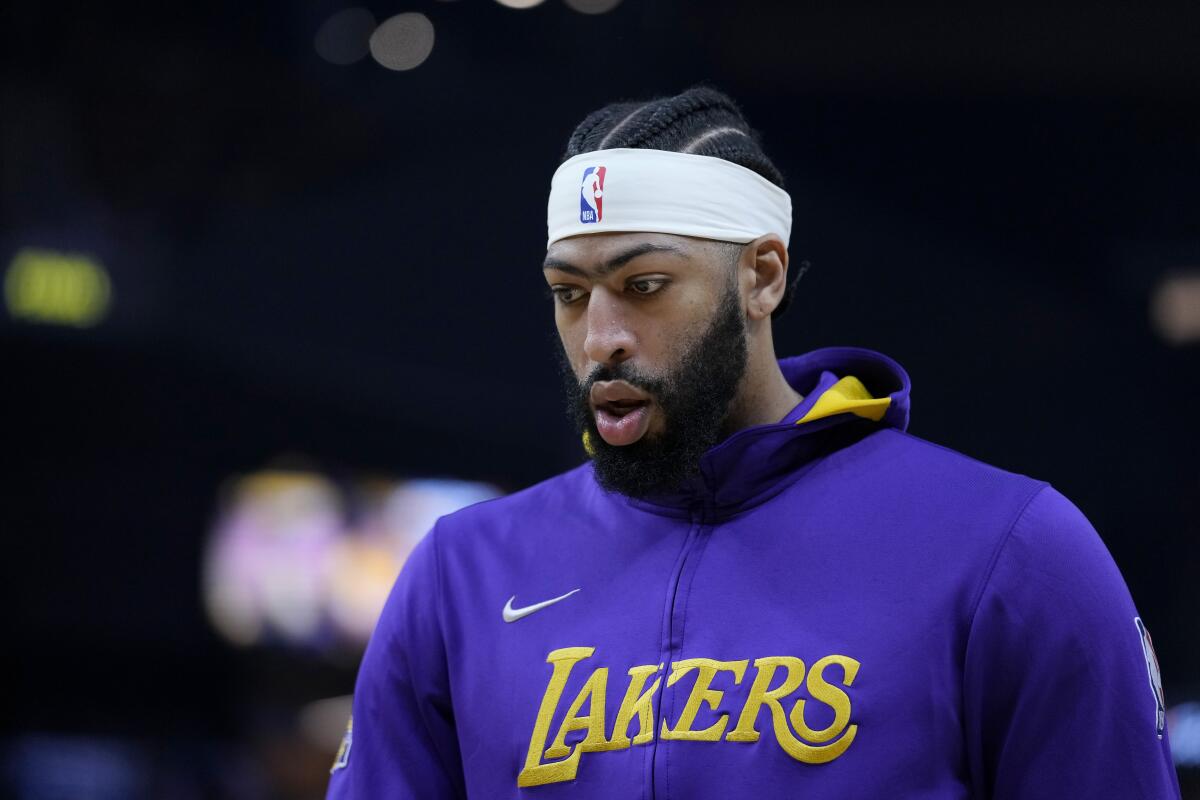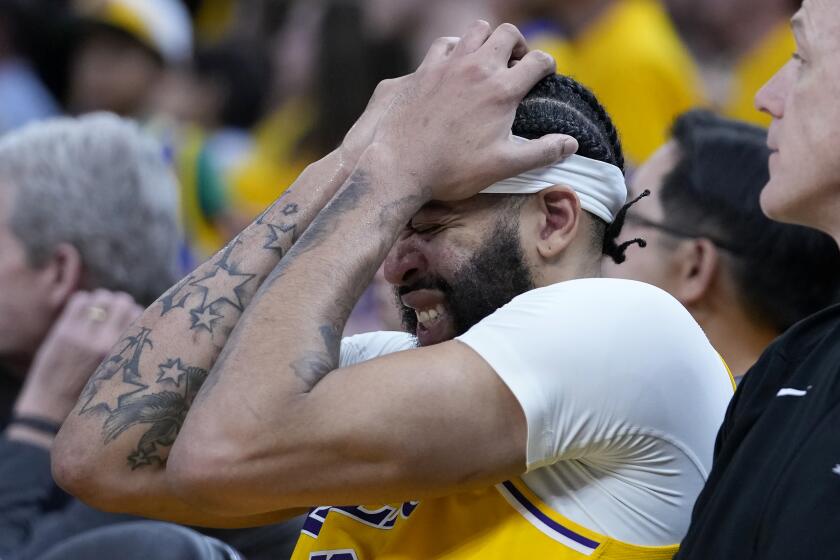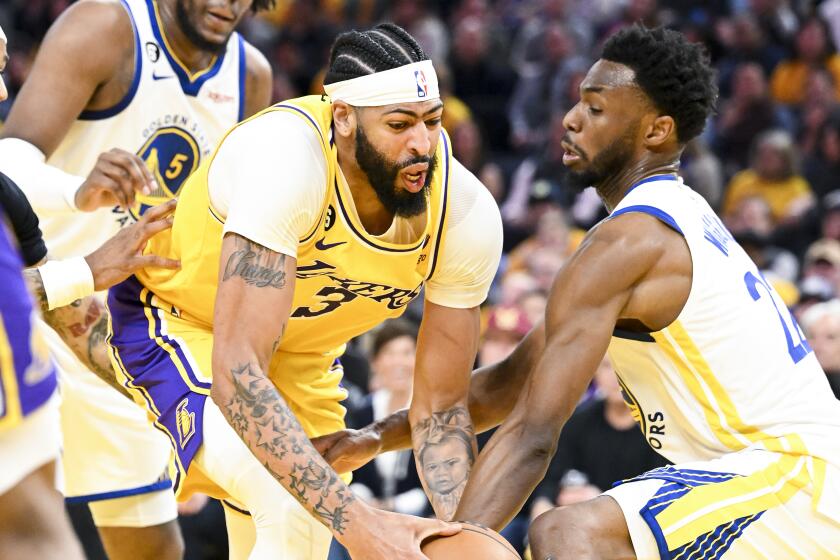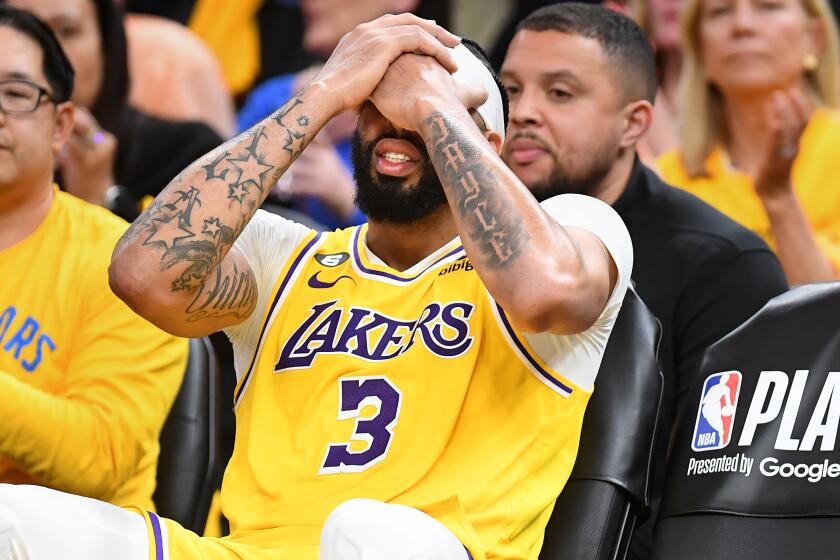Can Anthony Davis play in Game 6 after head injury? Here’s how NBA’s concussion policy works

- Share via
The wobbly walk. The dazed look. Hands grasping head.
Anthony Davis’ behavior after sustaining an elbow to the head Wednesday night was a scary sight.
TNT’s Chris Haynes reported after Golden State’s 121- 106 win over the Lakers that Davis “appears to have avoided a concussion.” Lakers coach Darvin Ham said Thursday that Davis isn’t showing signs of a concussion and the Lakers listed Davis as probable for Game 6 on Friday night.
That is great news for the Lakers. A look at the NBA’s concussion policy could shed some light on what might be happening behind the scenes. The policy states:
TV analysts Shaquille O’Neal, Charles Barkley and Stephen A. Smith seem to find amusement in a head injury sustained by Lakers star Anthony Davis.
“If a player is suspected of having a concussion, or exhibits the signs or symptoms of a concussion, he must be removed from participation by either a team physician, or an athletic trainer for the player’s team, and undergo evaluation in a quiet, distraction-free environment conducive to conducting a neurological evaluation. Prior to a player being allowed to return to game participation, the evaluating physician (or athletic trainer) is required to review video to assess mechanism.”
Based on how Davis was acting after absorbing the blow, it’s safe to assume that he was evaluated in the manner described above.
“If a player undergoes a concussion evaluation and is not diagnosed with a concussion, the team’s medical staff must continue to monitor the player, and the player must undergo at least another concussion evaluation by the team’s medical staff prior to the team’s next game or practice or approximately 24 hours after the initial concussion evaluation (whichever is first). If the player subsequently develops any signs or symptoms of a concussion, the player must immediately be removed from participation and undergo an additional concussion evaluation.”
This is what the Lakers feared, their fans dreaded and the Golden State Warriors needed. A possible Anthony Davis injury would turn series upside down.
This could be where Davis is at the moment. Any sign of a possible concussion could put his playing status for Friday at risk.
“Whether or not a player who undergoes a concussion evaluation is diagnosed with a concussion, the absence or presence of concussion in such a player must be reviewed by a physician with training and experience in the management of concussion within 24 hours of the injury. A physician must ultimately confirm the presence or absence of concussion and be involved in the management plan for the injury.”
Things would get much trickier if Davis is diagnosed with a concussion at any point.
“If a player is diagnosed with a concussion, he cannot return to participation: (i) for at least 48 hours, including the date of diagnosis; and (ii) until after he completes the required return-to-participation process.
Anthony Davis exited Game 5 in the fourth quarter after getting hit in the head by Golden State’s Kevon Looney. Lakers optimistic he avoided concussion.
“A player who is diagnosed with concussion should have his physical and cognitive exertion limited under the direction of his team’s medical staff. After a brief period of rest (24-48 hours) after injury, the player can be encouraged, under the direction of a team physician, to become gradually and progressively more active, so long as the activity level does not bring on or worsen the player’s symptoms.”
That timeline would seem to eliminate the possibility of Davis being allowed to take part in Game 6 and likely would put his status for a possible Game 7 at risk as well, as there are multiple steps of increasing exertion a player must complete with no set timeline in which they are supposed to take place.
After the player successfully completes those steps, and if he is symptom-free and has been evaluated by a physician who has been trained in concussion management, the team physician will consult with the director of the NBA concussion program before making the final return-to-participation decision.
More to Read
All things Lakers, all the time.
Get all the Lakers news you need in Dan Woike's weekly newsletter.
You may occasionally receive promotional content from the Los Angeles Times.










